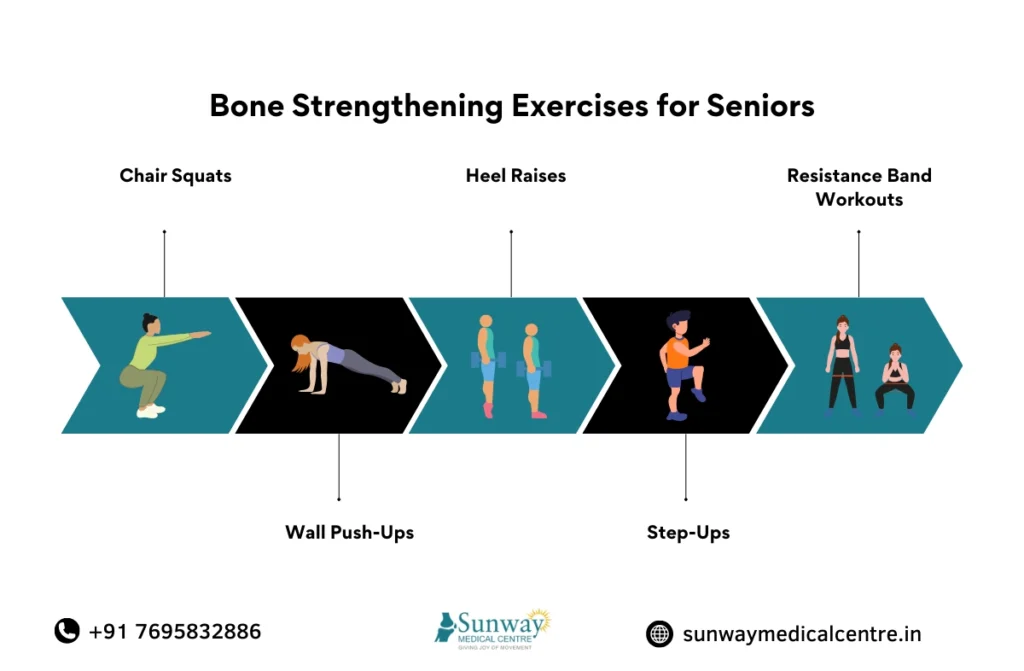Strong bones are the foundation of a healthy and active lifestyle. They support your body, protect vital organs, and store essential minerals like calcium and phosphorus. Engaging in bone strengthening exercises can help improve bone density, prevent conditions like osteoporosis, and reduce the risk of fractures treatment. At Sunway Medical Center, we encourage individuals of all ages to incorporate these exercises into their routines to build and maintain healthy bones. Whether you’re young, middle-aged, or a senior, this guide offers detailed insights into the best practices for keeping your bones strong.

8 Effective Bone Strengthening Exercises
Here are eight bone strengthening exercises that you can easily include in your daily routine to promote stronger bones and better overall health:
- Walking or Brisk Walking: This low-impact activity strengthens your legs, hips, and lower back while promoting cardiovascular health. Aim for 30 minutes a day.
- Dancing: Dancing combines weight-bearing movements with fun, improving bone density and coordination.
- Squats: Squats target the hips, thighs, and lower back, helping to strengthen bones and muscles in these critical areas. Start with two sets of 12 repetitions.
- Push-Ups: Build upper body strength and promote bone density in the arms and shoulders with push-ups. Modify them to suit your fitness level.
- Lunges: This dynamic exercise improves balance and strengthens the hips and legs. Perform 10–12 repetitions on each leg.
- Resistance Band Exercises: Resistance bands provide an excellent way to target specific muscle groups, making them particularly beneficial for bone strengthening exercises for seniors.
- Jumping Rope: A high-impact activity that enhances bone strength in the legs and hips while boosting cardiovascular fitness.
- Plank Variations: Strengthen your core and support spinal health with different plank variations.
Types of Bone Strengthening Exercises
To achieve optimal bone health, it’s essential to focus on activities that strengthen bones and muscles. These exercises can be broadly categorized into three types:
- Weight-Bearing Exercises: These involve movements that make you work against gravity. Walking, jogging, hiking, and dancing are great examples of weight-bearing exercises that promote bone strength.
- Resistance Training: Exercises using weights, resistance bands, or body weight help strengthen the muscles and the bones they support. Resistance training is particularly effective for spine strengthening exercises for osteoporosis, targeting areas that are prone to bone loss.
- Flexibility and Balance Exercises: Activities like yoga and Pilates enhance flexibility, posture, and balance, reducing the risk of falls. They are a great addition to any routine focused on exercises for strong bones.
How Does Exercise Improve Bone Health
Physical activity, particularly weight-bearing and resistance exercises, plays a crucial role in bone health. Here’s how:
- Increases Bone Density: Regular bone strengthening exercises stimulate bone-forming cells, increasing bone mass and strength.
- Enhances Muscle Support: Strong muscles help stabilize joints and reduce the risk of falls and fractures.
- Improves Balance and Flexibility: Exercises that challenge your balance also help prevent injuries.
- Slows Bone Loss with Age: Especially beneficial for seniors and postmenopausal women.
When you consistently strengthen bones and muscles, you create a protective framework that supports your entire body and reduces the chances of age-related bone diseases like osteoporosis.
How Exercise Builds Healthy Bones
When you engage in physical activities, especially weight-bearing and resistance exercises, your bones experience controlled stress. This prompts the bone remodeling process, during which old bone tissue is broken down and replaced with new, stronger tissue. Regular practice of bone strengthening exercises and activities to strengthen bones and muscles ensures that your bones remain dense and resilient.
Stretches for Spine Health
Stretching is an excellent way to complement your routine, especially for those focusing on spinal health. Here are some beneficial stretches:
- Cat-Cow Stretch: A yoga pose that gently mobilizes the spine, improving flexibility and relieving tension.
- Chest Openers: These stretches improve posture and flexibility in the upper spine.
- Side Stretches: Simple side stretches target the torso and enhance spinal mobility.
- Child’s Pose: A calming pose that stretches the lower back and hips, promoting relaxation.
- Seated Spinal Twist: A gentle twist that improves spinal flexibility and reduces stiffness.
Pairing these stretches with spine strengthening exercises for osteoporosis can enhance your overall spine health.
How Much Exercise is Enough
To maintain healthy bones, follow these guidelines:
- Frequency: Perform weight-bearing and resistance exercises 4–5 days per week.
- Duration: Aim for 30–60 minutes per session.
- Variety: Include a mix of cardio, strength training, and flexibility exercises to target different muscle and bone groups.
By adhering to this routine, you can effectively incorporate bone strengthening exercises and exercises for strong bones into your lifestyle.
Muscle-Strengthening Exercise
Muscle-strengthening exercise is any physical activity that increases muscle strength, tone, and endurance. These exercises include resistance training using weights, resistance bands, body weight, or even household items. While they primarily target muscles, they also help strengthen bones and muscles by putting healthy stress on the bones, which triggers bone growth.
Examples of muscle-strengthening activities:
- Weight lifting or resistance band workouts
- Push-ups, squats, and lunges using body weight
- Yoga and Pilates
- Functional movements like stair climbing and carrying groceries
When combined with bone strengthening exercises, muscle-strengthening workouts build a strong fobone strengthening exercises for seniorsundation for overall mobility, balance, and bone density.
Conclusion
Incorporating bone strengthening exercises into your daily routine is one of the best ways to ensure long-term bone health and prevent conditions like osteoporosis. Whether you’re looking to improve bone density, maintain mobility as a senior, or build strength for an active lifestyle, there are exercises tailored to your needs. At Sunway Medical Center, we are dedicated to providing personalized guidance and support to help individuals achieve their bone health goals.




